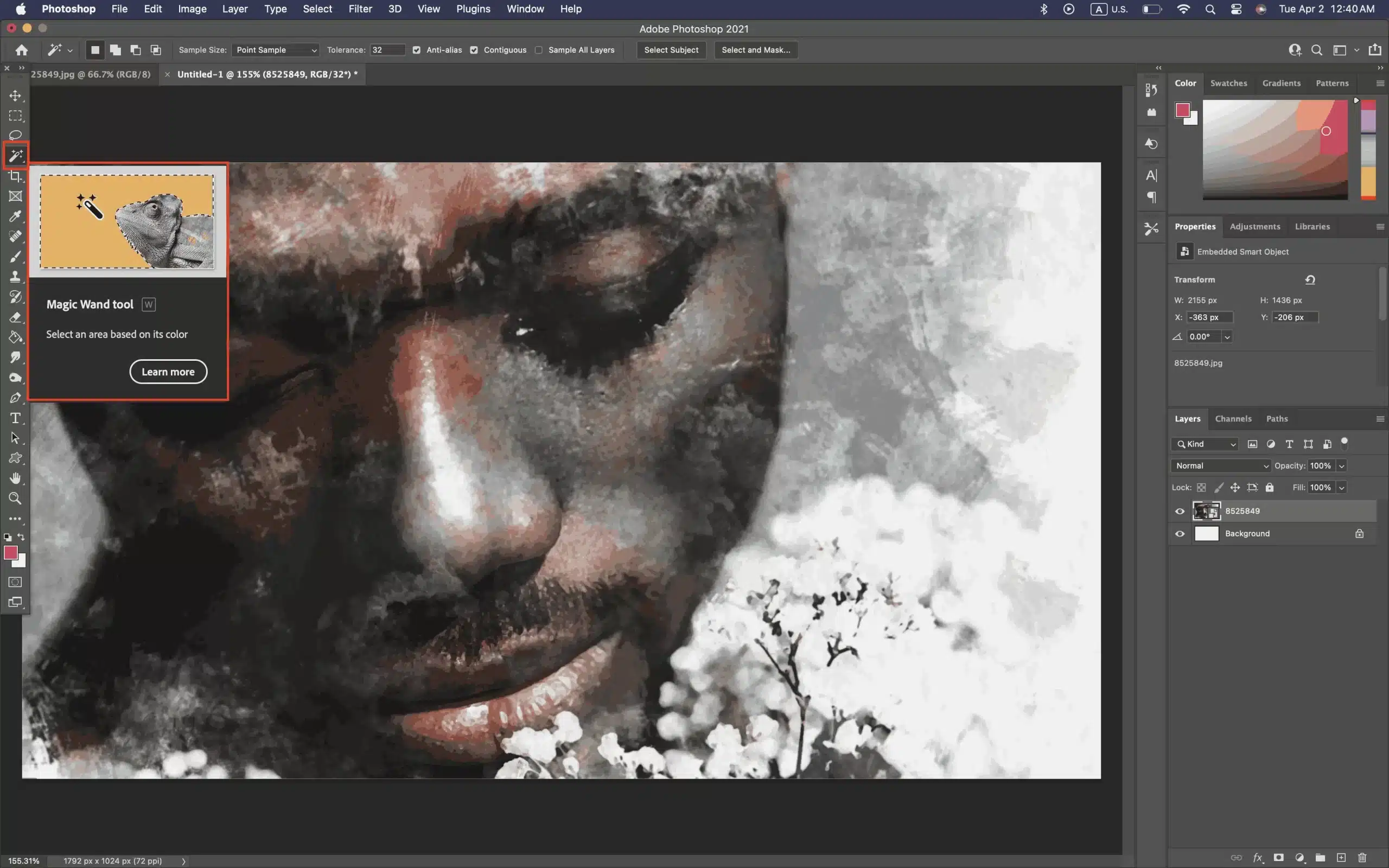
Mastering the art of Photoshop can be a daunting task for beginners, especially when it comes to using specific tools such as the Magic Wand. This tool is highly beneficial in selecting areas of any size of an image based on color and tone.
With just a click, users can quickly isolate background images or certain colors within their workspace.
In order to truly make use of this powerful feature, understanding its functionality is key. The Magic Wand tool operates by selecting pixels based on layers within your image. It offers several options that help control what gets selected during editing.
Diving into this guide will provide practical tips and step-by-step instructions on making the most out of the Magic Wand Tool in Photoshop.
Through patience and practice, you will soon be able to seamlessly edit your photos like a pro! Stay tuned for more detailed insights as we navigate through this beginner’s guide together.
Table of Contents
Mastering the Magic Wand Tool in Photoshop

As we dive further into the capabilities of the Magic Wand Tool in Photoshop, it’s essential to explore beyond the basics to truly harness its potential for your projects. With a focus on advanced techniques, we can streamline workflows and achieve more precise results.
Introduction to the Magic Wand Tool
The Magic Wand Tool is renowned for its simplicity and effectiveness in making selections based on color and tone. It’s your go-to for quickly isolating parts of your graphic for further manipulation.
But to use it like a pro, one must understand its subtleties.
- Familiarize yourself with the tool's settings, such as Tolerance and Anti-alias, to refine your selections.
- Hold the Shift key to add to your selection and the Alt key (Option on Mac) to subtract from it.
- For complex images, combine the Magic Wand with other selection tools for precision.
Understanding the Magic Wand's Functionality
The functionality of the Magic Wand Tool extends beyond mere color selection. It’s a gateway to advanced editing techniques that can significantly improve your workflow.
- Learn to adjust the Sample Size to get the selection just right. Working with a single pixel versus a 3x3 average can make a big difference.
- Explore the Use All Layers function to make selections across multiple layers without having to merge them.
- Remember, the Contiguous function will determine whether non-adjacent areas of similar color are selected.
Imagine you’re working on a multi-layered photo composite. The Use All Layers function allows you to select matching colors across all layers, simplifying the process of unifying color tones.
Pro Tip: Familiarize Photoshop’s smart selection tool to further enhance your workflow!
Adjusting Magic Wand Settings for Optimal Selection
Optimizing the Magic Wand Tool’s setting can turn a good selection into a perfect one. It’s about fine-tuning the controls to adapt to the nuances of your image.
- Experiment with the Tolerance level to include a broader or narrower range of colors.
- Toggle the Anti-alias feature to create smoother edges around your selections.
- Adjust the tool's settings in conjunction with a layer mask to hide or reveal parts of an image non-destructively.
For instance, when removing a background, you may need to adjust the Tolerance to avoid catching shadows or highlights that are similar to the main subject.
Advanced Techniques with the Magic Wand Tool
- Combine the Magic Wand with the Quick Selection tool to refine edge details.
- Use it in conjunction with adjustment layers to apply color corrections to specific areas.
- Master the art of feathering to blend selections seamlessly into the rest of the image.
A practical example would be to select a sky with the Magic Wand and then add an adjustment layer to enhance its vibrancy, without affecting the rest of the photo.
Combining the Magic Wand with Other Tools
The true power of the Magic Wand Tool lies in its ability to work in harmony with Adobe Photoshop’s vast array of other tools.
- After making your initial selection, refine it using the Selection Tools for a more polished outcome.
- Pair it with the Brush Tool to manually adjust selections or with the Eraser Tool to clean up any unwanted areas.
- Use the Magic Wand to create a base selection, then switch to the Lasso Tool for manual control over tricky sections.
Streamlining Your Workflow with the Magic Wand
- Memorize keyboard shortcuts to switch between the Magic Wand and other tools swiftly.
- Create actions that include the Magic Wand Tool for repetitive tasks to save time.
- Use the tool to quickly select and isolate objects for use in other projects or compositions.
For repetitive tasks, such as isolating products for an e-commerce site, actions that include the Magic Wand Tool can reduce editing time from minutes to seconds per image.
Mastering the Magic Wand Tool in Photoshop is about understanding its settings, knowing when to combine it with other tools, and practicing to streamline your workflow. With these skills, you will be well-equipped to tackle any editing challenge that comes your way.
Practical Applications of the Magic Wand Tool

The Magic Wand Tool in Photoshop is a versatile ally in graphic design, enabling users to quickly select and manipulate and even remove any object of their image based on color and tone. Let’s move beyond the basics and explore some practical, creative ways to use this tool on your selected objects.
Selecting Uniform Colors with the Magic Wand
- Open your project and choose the Magic Wand Tool from the toolbar.
- Set the Tolerance level in the options bar to determine the color range.
- Click on the color you want to select in your image. If the first attempt doesn't capture everything, adjust the original Tolerance layer and try again.
- To add to your selection, hold down the Shift key and click on additional areas.
- Once you're satisfied with the selection, you can adjust it further using the Refine Edge function.
Tip: Use the Magic Wand to swiftly remove a solid-colored background by selecting the background and then pressing delete or creating a mask.
Refining Edges for Accurate Selections
- After making your initial area selection, follow up by clicking on the 'Refine Edge' button in the options bar.
- Adjust the Edge Detection settings to refine the selection edges.
- Use the 'Refine Radius' and 'Erase Refinements' tools within the Refine Edge dialog to tweak the selection.
- Preview the changes in real-time and adjust as necessary to ensure a clean, accurate selection.
Tips for Advanced Magic Wand Techniques
- To select multiple non-adjacent colors, use the 'Add to selection' function with the Shift key.
- Combine the Magic Wand with the Quick Selection tool for complex images with both uniform and varied tones.
- Utilize the 'Sample All Layers' function to make selections based on the combined color data of all visible layers.
- For graphic design tasks, such as creating logos or web elements, pair the Magic Wand with shape tools to select and modify shapes with precision.
Remember, the key to harnessing the full potential of the Magic Wand Tool lies in experimenting with its settings for your images, photos, subject and objects all while further combining it with other features in Photoshop for optimal results.
Frequently Asked Questions

What is the Magic Wand Tool in Photoshop?
The Magic Wand Tool in Photoshop is a powerful feature for automating intricate selections based on color and tonal similarities within a specific area of an image of any size.
It is particularly useful for selecting high-contrast objects or backgrounds with minimal manual effort. It enables users to make selections based on a color range with adjustable tolerance settings, refining their selections to include pixels that the targeted range entails.
Why don't I have the Magic Wand Tool in Photoshop?
If the Magic Wand Tool is not visible in your Photoshop toolbar, it could be due to a customized workspace in which it has been removed or an issue with tool presets.
To find it, check for the tool under a different workspace, reset the tools to their default settings, or search for it in the Edit Toolbar function.
If you are using an older version of Photoshop, consider updating to the latest version. Software updates typically include all the necessary and improved features for your editing needs.
When using the Magic Wand Tool it is a good practice to turn on?
When utilizing the Magic Wand Tool, which options you choose can aid in achieving a more precise selection. It is good practice to:
- Engage the 'Anti-alias' feature to soften the edges of the selection, leading to a more natural integration with the rest of the image.
- Consider using the 'Contiguous' option to constrain the selection to adjacent pixels with similar colors.
- Employ the 'Sample All Layers' choice to base the selection on the combined color data from all visible layers, which is especially useful when working with layered documents.
How does the Magic Wand Tool determine which areas of an image to select?
- Color Matching: The initial pixel serves as a reference for the color match.
- Tolerance Setting: This governs the range of acceptable color variation, with a higher setting including a broader range of shades and a lower setting being more restrictive.
- Targeted Selection: Based on these parameters, the Magic Wand selects all the pixels within the preset tolerance level and potentially contiguous pixels if the contiguous option is enabled.
Conclusion
Reflecting on my journey through mastering the Magic Wand tool in Photoshop, I’ve come to appreciate it as more than just a feature; it’s a gateway to creative freedom.
Initially, the prospect of navigating Photoshop’s vast array of tools seemed daunting. Yet, as I delved into the intricacies of the Magic Wand tool, I discovered its potential to transform my workflow and elevate my projects.
The practical exercises and step-by-step guidance in this comprehensive guide have been instrumental in my growth. I’ve learned to manipulate selections with precision, blending backgrounds and isolating subjects with ease.
The tips on refining edges and combining the Magic Wand with other tools have been particularly enlightening, allowing me to achieve results that were once beyond my reach.
Additionally, Adobe’s other software, Lightroom, offers a different approach to image editing that you might find useful.
To dive deeper into digital image editing, consider taking this Lightroom course. With practice and patience, you will soon be creating stunning digital images that stand out from the crowd.
Read more about Photoshop:
















